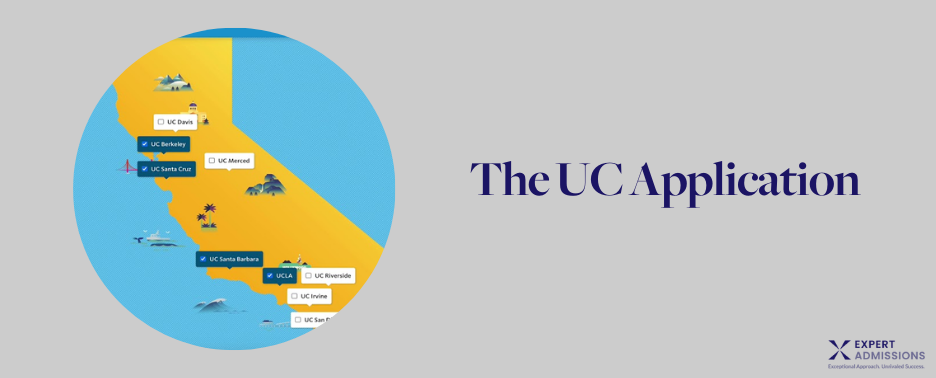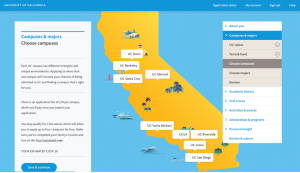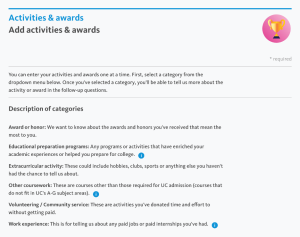
If you’re considering applying to schools in the University of California system, you should know that they have their own, unique application. Although they don’t accept the Common Application or Coalition Application, you only have to fill out one application for all the UCs you’re interested in. This guide will walk you through the sections of the UC application that are most different from what you’ll encounter on the Common App. A detailed walkthrough of the application can be found here.
Choosing Campuses and Majors on the UC Application

When you’re filling out your UC Application, there can be a temptation to just check every box and apply to all the UC campuses. But there are some good reasons not to do that. First of all, it’s costly. There is a fee of $70 for each UC campus you apply to. And even if cost isn’t an issue, these campuses are very different—geographically, socially, academically—and it’s unlikely that you would truly be just as happy at any of them. As with all of your college applications, fit matters, and the UC admissions officers will be looking for fit with their specific campuses. For more on the differences between UC campuses, check out our guide here.
Note that if you’re applying to UC San Diego, you will also need to indicate which undergraduate colleges you’re interested in. UC San Diego is unusual in that the undergraduate colleges are not linked to majors; all undergraduates can choose any of the majors offered by the university. What’s important about your choice of college is everything else! Each college has its own campus culture, residential facilities, and even distinct general education requirements. More information on each of UC San Diego’s undergraduate colleges can be found here.
As for indicating a major, there’s a lot to consider! Most campuses will allow you to select a major and an alternate major. You can use this strategically—if your primary interest is in a major with limited enrollment that may be more difficult to get into, you can select an alternate major with more flexibility (assuming there’s one you’d genuinely be interested in).
When considering majors and alternate majors, it’s important to know that some, but not all, of the UCs admit by major; and whether they admit by major can also vary by program. UC San Diego and UC Merced seem to be the only campuses that truly do not admit by major—if your first-choice major is “capped” (meaning there is limited enrollment), you will be required to indicate an alternate that is not capped or choose “undecided.” You can be accepted to the campus without being guaranteed your major of choice.
UC Irvine and UC Riverside both admit by major across disciplines, but for the rest of the UC campuses, it depends. For the most part, at the other UCs, you’ll only be admitted by major if you choose a highly popular or competitive program. These include many STEM fields, especially engineering and computer science, as well as arts programs that would require an audition or portfolio as part of your application.
The UC Application Activities Section

If you’ve already created your Common App account, you might think the UC Activities & Awards section looks familiar. But there are important differences between the two, and it’s not enough to simply copy and paste your activities from the Common App here.
Note the different categories that the UCs list under Activities & Awards. This category includes educational programs and any coursework you took outside of high school (like a college course), as well as awards and honors—all of which would be under “Education” on the Common App.
Another big difference is how long your descriptions are allowed to be. While the Common App allows 150 characters to describe each activity, the UC Application allows up to 350 characters—more than double.
And lastly, on the UC Application, you can list up to 20 activities or awards (with no limit on how many of those fall into each category), compared to the 10 activities allowed on the Common App.
While some of these categories are fairly straightforward, others may give you pause. Here are some key tips for filling out the activities section of the UC application:
- List activities or awards in order of their importance to you, including considering where you’ve made the biggest impact.
- Educational Prep Programs tend to be community-based organizations, and the UC Application provides a dropdown list of common programs (e.g., Educational Talent Search, GEAR UP, MESA, and various study abroad programs). If you participated in a program that is not on the list, you will have the option to manually enter the information.
- Other Coursework refers to courses that don’t fall under the “A-G” categories you’ll be asked to fill in under the “Academic History” section. The UCs require that you complete (and pass) a minimum of 15 courses in seven categories, lettered A through G—History, English, Mathematics, Science, a language other than English, Visual and Performing Arts, and College Preparatory Electives.
Any coursework done outside of these categories falls under “Other Coursework.” This might include high school courses on leadership or religion or college courses you’ve taken.
UC Application Personal Insight Questions


When approaching the UC personal insight questions (PIQs), think about which prompts will give admissions officers the best sense of who you are and what you care about. Remember that you only need to answer four of them, so you should choose the prompts that are most relevant to your own experience. To make the most of your PIQs, keep this advice in mind:
- Focus on you. Whatever the question, ask yourself what you did, felt, thought, experienced, etc. If you’re describing a challenge you faced or a subject that inspires you, for example, it’s very easy to spend a lot of your essay writing about what the challenge was or what you like to study. But that doesn’t tell admissions officers much about you. What did you feel when you faced your challenge, and what concrete steps did you take to overcome it? What excites you about a particular academic subject, and how have you actively pursued it?
- Highlight impact. The prompts about leadership and community are specifically asking about your contributions, but there are other ways to make an impact as well. When writing your essays, think about where and how you made a positive difference.
- Provide depth. Some of these prompts could probably be answered by writing on topics you’ve listed in the Activities and Awards section. And that can even be a great place to look for a topic you want to say more about. But if you feel like the description you gave in that section tells most of the story, it’s probably not a good topic for a PIQ. You want topics that will let you add your perspective and showcase who you are, not just what you participated in.
- Avoid overlap. If possible, you should choose four questions that let you write about different activities, interests, or experiences. This will let you showcase more of who you are and what you do.
- Think outside the box. For example, leadership doesn’t have to mean a title, creativity doesn’t have to be artistic, and your community doesn’t have to be your school or a local organization. Leadership can be mentoring others or organizing a project or event. You can be creative in how you approach problems or make connections between ideas. And a community can be geographically diverse as long as there is mutual connection and influence within it.
Leave a Reply